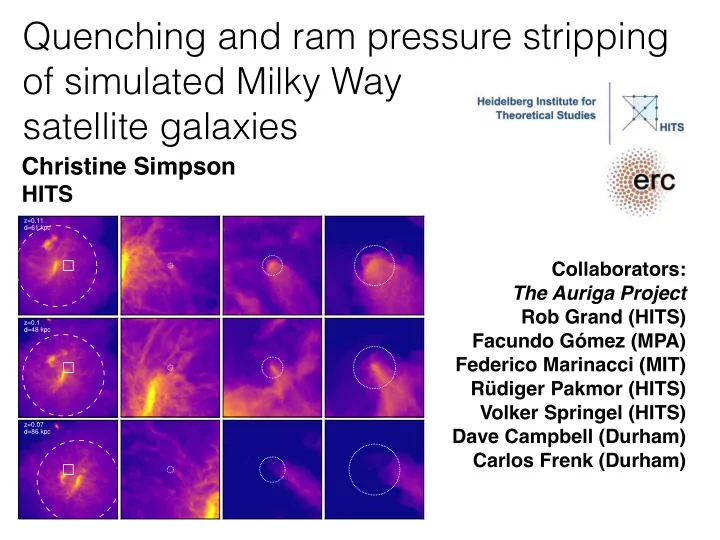

Quenching and ram pressure stripping of simulated Milky Way satellite galaxies Christine Simpson HITS z=0.11 d=61 kpc Collaborators: The Auriga Project Rob Grand (HITS) z=0.1 d=48 kpc Facundo Gómez (MPA) Federico Marinacci (MIT) Rüdiger Pakmor (HITS) Volker Springel (HITS) z=0.07 Dave Campbell (Durham) d=86 kpc Carlos Frenk (Durham)
Many substructure puzzles in the Local Group •‘Missing satellites’ •‘Too big to fail’ •cores vs. cusps •planes of satellites Solution(s)? Dark matter? Gravity? Baryons? All of the above?
What do we know about baryons in LG dwarfs? Environment Mass Fraction of quenched Few systems with measured systems increases with H I within ~270 kpc of host decreasing luminosity Grecevich & Putman 2009 Weisz et al. 2015
The Auriga Project Grand et al. 2017 physical volume: 400 kpc The Set-up & Physics • Thirty cosmological zoom simulations of 10 12 M ⊙ halos • DM particle mass ~ 3 x 10 5 M ⊙ ; baryon cell/particle mass ~ 5 x 10 4 M ⊙ • Second-order hydrodynamics on a moving mesh (AREPO) • MHD, SF & stellar feedback, AGN feedback, UV background, atomic & metal line cooling
Satellites & Dwarfs in Auriga 10 2 systems within 300 kpc MW M31 Cumulative Number L4 • Cumulative number of luminous satellites match 10 1 the MW and M31 10 0 10 6 10 7 10 8 10 9 10 10 10 11 M star (M � ) systems within 1 Mpc • Luminosity of systems lie above predictions for central galaxies from abundance matching extrapolations Simpson et al. 1705.03018
Quenching of Satellites All (672) 1 . 0 Fraction of Quenched Satellites 0 . 0 - 0 . 3 Mpc (356) 0 . 3 - 0 . 6 Mpc (191) 0 . 8 • All distance bins show 0 . 6 - 1 . 0 Mpc (125) 0 . 6 more quenching at lower 0 . 4 masses 0 . 2 • The most isolated 0 . 0 systems only quench 10 6 10 7 10 8 10 9 10 10 10 11 strongly at M star < 10 7 M ⊙ Final M star (M � ) All (672) • Above M star > 10 8 M ⊙ 1 . 0 5 × 10 5 - 10 7 M � (323) Fraction of Quenched Satellites 10 7 - 10 8 M � (203) 0 . 8 almost all systems are > 10 8 M � (146) 0 . 6 star-forming 0 . 4 0 . 2 0 . 0 Simpson et al. 1705.03018 0 . 0 0 . 2 0 . 4 0 . 6 0 . 8 1 . 0 Final Distance (Mpc)
Mechanisms? Ram Pressure? Simpson et al. 1705.03018
z=0.2 x 1.0 x 4.0 x 16.0 x 32.0 d=207 kpc Ram pressure is the dominant quenching mechanism 100 kpc 25 kpc 6 kpc 3 kpc z=0.14 d=118 kpc •This system is ~ 6.3 x 10 6 M ⊙ in stellar mass •The half-stellar mass z=0.11 d=61 kpc radius expands by ~45% during this ram pressure stripping event z=0.1 d=48 kpc z=0.07 d=86 kpc Safarzadeh & Scannapieco 2017 Simpson et al. 1705.03018
z=0.2 x 1.0 x 4.0 x 16.0 x 32.0 d=207 kpc Ram pressure is the dominant quenching mechanism 100 kpc 25 kpc 6 kpc 3 kpc z=0.14 d=118 kpc •This system is ~ 6.3 x 10 6 M ⊙ in stellar mass •The half-stellar mass z=0.11 d=61 kpc radius expands by ~45% during this ram pressure stripping event z=0.1 d=48 kpc NGC 3359 Hsyu+ 2017 z=0.07 d=86 kpc Safarzadeh & Scannapieco 2017 Simpson et al. 1705.03018
Observed 10 . 0 9 . 8 9 . 6 quenching log( τ 90 /yr) 9 . 4 9 . 2 times 9 . 0 8 . 8 8 . 6 − 18 − 16 − 14 − 12 − 10 − 8 휏 90 is the time by which Final M V 90% of a system’s stellar 10 . 0 mass formed 9 . 8 (data: Weisz et al. 2015) 9 . 6 log( τ 90 /yr) 9 . 4 9 . 2 9 . 0 8 . 8 8 . 6 0 . 0 0 . 2 0 . 4 0 . 6 0 . 8 1 . 0 Simpson et al. 1705.03018 Final Distance (Mpc)
Backsplash galaxies d < R 200 (276) 1 . 0 d > R 200 backsplash 0 . 8 (165) Quenched Fraction ‘Backsplash’ galaxies: d > R 200 non-backsplash 0 . 6 systems that have been (233) within R 200 in the past but 0 . 4 not at z = 0 0 . 2 0 . 0 10 6 10 7 10 8 10 9 10 10 10 11 Final Stellar Mass (M � ) Simpson et al. 1705.03018
Simpson et al. 1705.03018 Conclusions All (672) 1 . 0 Fraction of Quenched Satellites 0 . 0 - 0 . 3 Mpc (356) 0 . 3 - 0 . 6 Mpc (191) 0 . 8 0 . 6 - 1 . 0 Mpc (125) • Satellites in Auriga match 0 . 6 general trends found in the 0 . 4 Local Group (numbers, 0 . 2 quenched fractions, distance 0 . 0 trends) 10 6 10 7 10 8 10 9 10 10 10 11 Final M star (M � ) • 50% of quenched systems All (672) 1 . 0 5 × 10 5 - 10 7 M � (323) Fraction of Quenched Satellites do so within 1 Gyr of first 10 7 - 10 8 M � (203) 0 . 8 > 10 8 M � (146) infall 0 . 6 • Ram pressure stripping 0 . 4 appears to be the dominant 0 . 2 quenching mechanism of 0 . 0 0 . 0 0 . 2 0 . 4 0 . 6 0 . 8 1 . 0 satellites in Auriga Final Distance (Mpc) Weisz et al. 2015
Recommend
More recommend